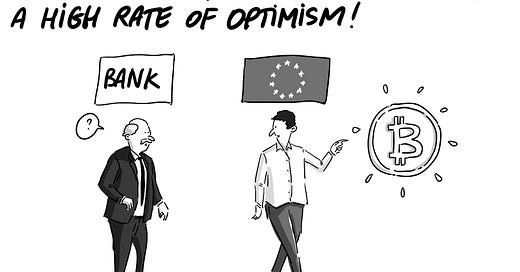
Discover more from Cointribune
European Optimism for Crypto, Bitcoin, and Monetary Policy 🌐
Welcome to the Daily Tribune, Tuesday, January 30, 2024 ☕️
Hello Cointribe! 🚀
Today is Tuesday, January 30, 2024, and like every day from Tuesday to Saturday, we summarize the news of the last 24 hours that you shouldn't miss!
But first…
✍️ Cartoon of the day:
A quick look at the market…
🌡️ Temperature:
Sunny ☀️
24-hour crypto summary ! ⏱️
Crypto: European Optimism Despite Clouds 🌤️
A recent survey by Binance reveals a notable enthusiasm in Europe for the future of cryptocurrency, despite the current challenges in the industry. This optimism is driving 73% of European residents towards increased adoption of digital assets in daily life, especially in France, where the use of cryptocurrency in daily transactions has significantly increased. This phenomenon is part of a global trend, with a 34% increase in the number of crypto holders in 2023.
The adoption of cryptocurrency in Europe goes beyond mere optimism. The high returns offered by crypto investments are attracting more individuals seeking alternatives to traditional markets. Europeans see crypto as a means to diversify their financial portfolios and participate in an emerging economic revolution.
European optimism for crypto, despite economic turbulence, could signal a transition to a more decentralized and digital economy. This reflects a growing recognition of cryptocurrencies as not only speculative assets but also potential instruments for economic diversification and resilience in the face of global uncertainties. France, in particular, seems to be embracing this transition, indicating a possible shift in policies and traditional banking practices towards a more integrated use of digital assets.
China and Crypto: An Unexpected Turn? 🔄
The liquidation of the Chinese real estate giant Evergrande, crushed by massive debt, has caused a shock in the country's real estate sector, already weakened by the crisis and restrictive policies. This alarming situation has led to a drastic drop in new home sales and prices, putting the Chinese economy at risk. In response to this unprecedented crisis, China is considering massive stimulus measures and, surprisingly, a relaxation of its stance on cryptocurrencies.
Although cryptocurrencies are officially banned in China, their authorization could become a tool to stimulate domestic consumption and revive the economy. The use of yuan-backed stablecoins is being considered to quickly inject liquidity into the real economy. This prospect, unthinkable not long ago, reflects the Chinese authorities' distress in the face of the systemic crisis in the real estate sector, which has traditionally been a driving force behind the country's economic growth.
The Evergrande crisis in China and its impact on the potential opening to cryptocurrencies could indicate a tipping point for the global finance. This suggests that even centralized and regulated economies could be forced to recognize and integrate cryptocurrencies in response to financial crises. If this pivot becomes a reality, it could mark a historic moment where cryptocurrencies shift from being an alternative to becoming essential in managing economic crises.
Bitcoin and the Fed: An Undeniable Link? ⚖️
The world of cryptocurrencies, especially Bitcoin, remains attentive to the movements of the US Federal Reserve (Fed) regarding interest rates. Speculations about a possible rate cut in March add uncertainty. Such a rate cut could lead to an increase in the amount of money in circulation, which would favor Bitcoin, often seen as a hedge against inflation.
Decisions by the Fed are influenced by the health of the US labor market. Improvement could lead to a tighter monetary policy, potentially unfavorable to Bitcoin. Conversely, a weak labor market could result in a looser policy, beneficial for BTC. The introduction of Bitcoin ETFs in the United States has also played a key role, although the price of BTC has experienced fluctuations since then. Investors remain on alert, anticipating the next market movements.
The imminent decision of the US Federal Reserve on interest rates could have a significant impact on the price of Bitcoin. A rate cut would mean cheaper currency and more money in circulation, which could favor Bitcoin as a hedge against inflation.
Strengthens Control over Crypto Companies Outside its Borders 🚧
The European Union (EU) has introduced stringent directives for cryptocurrency companies based outside the EU. These measures aim to prevent unfair competition and strengthen investor security. Non-European companies will only be able to operate in the EU if the client expressly requests it, through an initiative known as "reverse solicitation." This rule obliges foreign companies to consider opening a subsidiary within the EU.
The objective of the EU is to protect investors and service providers compliant with MiCA regulations. The ESMA proposals limit the application of crypto services by third-country companies, allowing only direct requests from clients. Active solicitation, including marketing campaigns in the EU, remains prohibited for these companies. The EU aims to strengthen its regulatory framework for cryptocurrencies, protecting its citizens and financial markets.
This regulation illustrates the EU's determination to protect its market and citizens and could have a profound impact on the cryptocurrency industry.
Coin of the Day: Pendle (PENDLE)
Pendle (PENDLE) is a cryptocurrency launched in 2021, operating mainly on the Ethereum blockchain. It stands out for its innovative approach in the decentralized finance (DeFi) field, offering a platform for trading yield farming futures contracts. Pendle's added value lies in its ability to allow users to separate the ownership of assets from their future yields, thus offering increased flexibility and liquidity in DeFi investment management.
PENDLE holders benefit from various advantages, including participation in protocol governance, liquidity incentives, and potentially higher returns through innovative trading strategies. Pendle can be used to speculate on the future yields of DeFi assets, offering a new layer of financial strategies in the crypto ecosystem.
Recent Performance
Current Price: 2.70 USD (approximately 2.50 €)
Percentage Increase/Decrease: +20.11% (increase over 1 day)
Market Cap: Approximately 643.5 million USD (approximately 595.7 million €)
Rank on CoinMarketCap: 96
Crypto Analysis of the Day: Bitcoin (BTC)
Bitcoin has recently demonstrated remarkable resilience by staying above the crucial support level of $40,000. After a period of decline, it closed the week of January 22 on a positive note, starting the new week above $42,000. This movement formed a \"hammer\" above the support at $41,500, a classic sign in technical analysis that can indicate a bullish reversal. Currently, Bitcoin is trading above $43,000, a level that has recently acted as resistance. This level also corresponds to the 50% Fibonacci retracement level calculated from Bitcoin's last peak. This rebound has allowed Bitcoin to reintegrate its 50-day moving average, reinforcing investor confidence in the continuation of the bullish trend.
Oscillators, which help identify market dynamics, have responded positively to this movement. This suggests that Bitcoin's medium- and long-term trend could be on the rise. However, a bearish divergence between these oscillators and the price of Bitcoin indicates a potential downside risk. It is crucial to carefully observe the price's reaction at various key levels to confirm or refute the current assumptions. Stay vigilant in the face of potential market "fake-outs" and "squeezes" in each scenario.
If Bitcoin manages to stay above $42,000, we could anticipate a further rise towards the $45,000 threshold. The next resistance levels to watch, if the bullish movement continues, would be around $46,000 and $49,000. However, if Bitcoin fails to stay above $42,000, a return to $40,000 could be considered, with a potential downside to around $38,500. These analyses are based solely on technical criteria, and the price of cryptocurrencies can evolve quickly based on other more fundamental factors.
Subscribe to Cointribune
We're pleased to provide you with not just one, but two newsletters: The Daily, from Tuesday to Saturday at 10:30 AM, and The Weekly every Monday morning at 10 AM, perfectly timed for your coffee break.


















